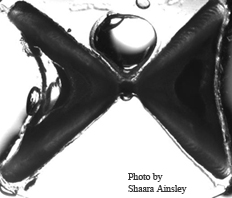
Congrats to Shaara Ainsley of the ichthyology lab who recently defended her thesis and joined the ranks of many other recent MLML grads! Here Shaara shares a bit about her research, and addresses that all-important question: what does it mean to “age” a skate? (aka a flat shark…)

by Shaara Ainsley, Ichthyology Lab
For my thesis, I studied the life history characteristics of a skate from Alaska, Bathyraja interrupta, commonly known as the Bering skate. Knowing the life history of a species of fish is important because fisheries managers use the information to determine whether a fish is vulnerable to overexploitation, or can be fished at a certain level to maintain a healthy population.
So what are “life history parameters,” and how do we study them? From a fisheries management perspective, it is important to know how long the fish lives, how big the fish can get, how many offspring the fish can have, and how often it can reproduce. Estimating the age of an individual fish is at the heart of a life history study. In fisheries biology lingo, this is called “ageing” a fish. Ageing (spelled with the “e”) does not mean that we make the fish older, nor does it mean that we set it aside for a few years like a fine wine! It means that we are looking at structures in the body of a fish that can give us clues about how long the fish has been alive.

Just like trees, fishes deposit rings or “bands” in their bones. Specifically in boney fishes, such as a rockfish, you can look at the ear bone (or “otolith”) and count the bands to estimate the age. In sharks, skates and rays, which are cartilaginous and do not have boney structures, we can count the bands deposited on their vertebrae. There are many additional aspects of a fish’s life history that are important to management, however the majority of my research has focused on the age and growth of skates. Through my research, I have estimated that the Bering skate can live to at least 22 years old, which is an average life span compared with other skate species.
What is the hardest part about studying how old these skates get? Stay tuned to find out!

